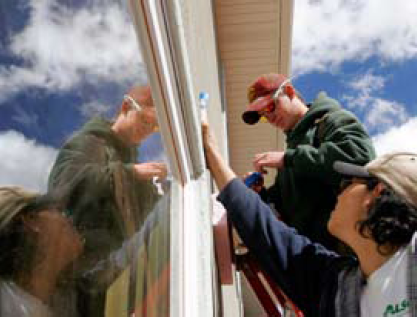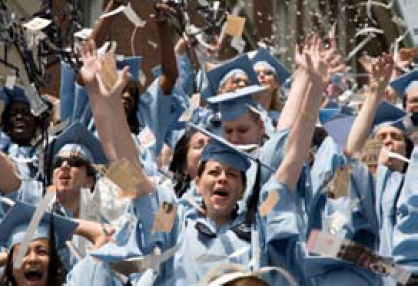
Traditional four-year institutions range from small liberal arts colleges to massive state universities in places like California, Arizona, Ohio, and New York, each with multiple campuses and student populations exceeding 30,000. Approximately one third of U.S. colleges and universities are private and generally charge tuition costs substantially higher than state-run public institutions.

North Carolina State University classroom with many veterans in the 1950s.
For much of their history, American institutions of higher learning remained bastions of privilege, with a predominantly white, male population. That pattern didn’t change significantly until passage of the G.I. Bill in 1944, when the federal government paid for millions of World War II veterans to attend college. (G.I., which stands for “government issue,” became a casual term for any Army soldier in World War II.)
The G.I. Bill of Rights included subsidies for attending virtually any recognized institution of higher learning, as well as payments for vocational training and subsidies to encourage home ownership. Congress didn’t expect many to take advantage of the college provision, but within two years more than 1 million veterans were enrolled at the nation’s colleges and universities, doubling the number of college students. Over a seven-year period, the G.I. Bill enabled more than 2.2 million veterans to attend college.
The social impact of the G.I. Bill has been little short of revolutionary. As scholar Milton Greenberg points out, “Today, American universities are now overwhelmingly public, focused heavily on occupational, technical, and scientific education, huge, urban-oriented, and highly democratic.” In subsequent decades, colleges and universities grew rapidly, as veterans were followed by their children, the so called baby boom generation that began entering college in the
1960s.
Colleges and universities also began opening their doors wider to minorities and women. In recent years, more women than men have been attending colleges and universities and earning more bachelor’s and master’s degrees — a pattern that shows no signs of changing, according to the National Center for Education Statistics.
The proportion of minority students attending college has increased as well — from 14 percent in 1981 to 27 percent in 2005. Much of the change can be attributed to growing numbers of Hispanic and Asian students. African American enrollments rose from 9 percent to 12 percent in the same period.

Responsible citizens learn about “Democracy in Action” at Philadelphia’s Constitution High School.
Higher education in the United States is an enormous enterprise, costing almost $373 billion and consuming nearly 3 percent of the nation’s gross domestic product. College costs for students can be high, especially for private institutions, which do not receive general subsidies from either state or federal governments. To ensure equal access to education for all, the United States administers an extensive financial aid program for students. Seven out of 10 students receive some form of financial aid, which typically combines grants, loans, and work opportunities to enable full-time students to meet their living costs and tuition.
Recently, several of the nation’s wealthiest and most prestigious universities — schools like Harvard, Princeton, Yale, Columbia, and Dartmouth, among others — announced plans to substantially increase their financial aid for low- and middle income families.
Students compete for openings in the nation’s better colleges and universities. At the same time, American institutions of higher learning of all types must broadly compete for the nation’s top students and to admit sufficient numbers to maintain their enrollments. The most prestigious American universities — public and private — receive hundreds of applications for each opening. At the same time, it is true that most secondary school graduates with good grades and strong scores on college entrance exams receive hundreds of solicitations from institutions of higher learning.
Reflecting the decentralized nature of American education, state governments may license institutions of higher learning, but accreditation, which grants academic standing to the college or university, is accorded by nongovernmental associations, not by states or the federal government.
Community Colleges
For an American high school graduate with a modest academic record and limited funds, enrolling in a community college may be a better option than attending a four-year college or university.
Two-year, associate-degree programs in such growing professional fields as health, business, and computer technology can be found at most of the nation’s roughly 1,200 community colleges.
Community colleges are also gateways to four-year undergraduate institutions for students who need to bolster mediocre high school grades with stronger college credits.
Taking advantage of low fees and liberal admissions policies, more than 11 million American and an estimated 100,000 international students now attend community colleges.
HBCUs
Most Historically Black Colleges and Universities (HBCUs) were founded at times when either slavery or segregation ruled the South, and higher education for African Americans elsewhere was ignored or marginalized. Although the first college for African Americans — now Cheney University of Pennsylvania — was established in 1837, many of today’s most prestigious black schools were established immediately after the Civil War, including Fisk University in Nashville, Tennessee; Howard University in Washington, D.C.; and Morehouse College in Atlanta, Georgia.
Nineteen public HBCUs were founded with passage of the Second Morrill (Land Grant) Act in 1890 — many in the then firmly segregated South.
Today the White House Initiative on HBCUs counts 40 four-year public colleges and universities, 50 four-year private colleges, and 13 two-year community and business schools.

Nursing students at Hampton University, one of the Historically Black Colleges and Universities.
Study in the United States
Foreign students have long been a familiar and vital element of American higher education. In the 2006-2007 academic year, according to the publication Open Doors, almost 583,000 international students were enrolled in many of America’s 4,000 colleges and universities, an increase of 3 percent over the previous year. India remains the largest single source of foreign students, followed by China, Korea, and Japan.
The top five areas of study for international students are business and management, engineering, physical and life sciences, social sciences, and mathematics and computer science.
International students attend U.S. colleges and institutions for the same reasons that Americans do: academic excellence, unparalleled choices in types of institutions and academic programs, and great flexibility in designing courses of study and even in transferring between different institutions.
With a wide range of tuition and living costs, plus opportunities for financial aid, foreign students find that a U.S. education can be affordable as well. Most large schools have international student advisers, and a worldwide network of student-advising centers, along with a variety of publications, can guide prospective students through the sometimes complicated process of finding, applying, and being accepted by an American college or university.

Journalism school graduates at New York’s Columbia University.



















